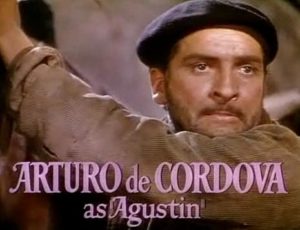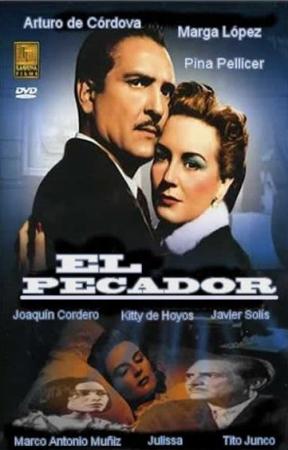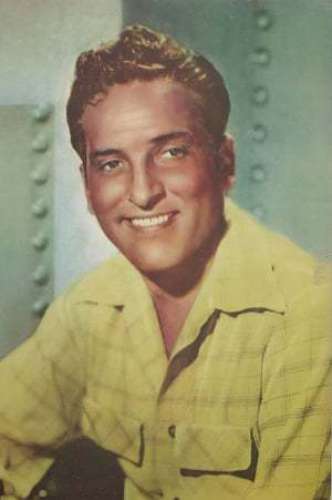ARTURO DE CORDOVA, DISTINGUISHED ACTOR OF WORLD CINEMA (CUBAN DESCENDANT). VIDEOS
Arturo García Rodríguez, a famous distinguished artist in several countries where he had an extensive film career, was born in the city of Merida, Yucatan on May 7, 1907, and was known by his artistic name of Arturo de Cordova.
His parents were Arturo García Pujol and Isabel Rodríguez Echeverría Muro, both were Cubans living in the city of Mérida. Until he was seven years old, he lived in his hometown. Then his family took him to the United States where he stayed until he was 12 when they moved to Argentina, and later his parents sent him to Switzerland to study languages.
In 1932 he sought to emigrate to the United States, but during the trip he made a stopover in Mérida to recognize his hometown, staying there for several months after being “bewitched” by a beautiful young woman named Enna Arana, with whom he ended up marrying on August 23. from 1933.
https://youtu.be/pyoD8n8MKYE
ARTURO DE CORDOVA FILMS (VIDEOS)
It was his friend Roberto Cantú Robert who suggested that he change his name from Arturo García Rodríguez to Arturo de Cordova when he made his film debut since García sounded too common and Cordova’s gave him an aristocratic and aristocratic bearing. ancestry and refers to the city of Córdoba (Argentina) where he lived in his childhood.
ARTISTIC CAREER
He began his film career in the film “Jealousy” (1935), directed by the Russian immigrant Arcady Boytler, sharing the bill with the famous actor Fernando Soler. Later he took part in the film “Cielito Lindo” (1936), which would be the only one in his entire career where he would play a charro and even sing, which was not appropriate since neither the song nor the dance was his skills. It is in the film “Ave Sin Rumbo” (1937) starring alongside the star Andrea Palma, where Arturo de Córdova begins to outline his classic character as a tormented heartthrob that he would interpret in titles such as: “Ave Sin Rumbo” (1937); “The Count of Montecristo” (1941); “Twilight” (1944); “May God Pay it to You” (1948); “The Forest of Fire” (1945); “The Kneeling Goddess” (1947); “The Man Without a Face” (1950); “Stolen Paradise” (1951); “When the Fog Raises” (1952); “The” (1952); “The Delivery” (1954); “Happy New Year, My Love” (1955); “Ash Wednesday” (1958) to mention just a few.
https://youtu.be/SwSUQ7qxzP0
ARTURO DE CORDOVA FILMS (VIDEOS)
In his long career, he did not pigeonhole himself into the role of a tragic heartthrob, but rather knew how to exploit his comic side by making such funny films as: “Five Minutes of Love” (1941), “Five Faces of a Woman” (1946); “His Last Adventure of him” (1946); “My Wife and the Other” (1951); “The Three Perfect Married” (1952); “A Media Luz los Tres” (1957); “My Wife Understands Me” (1957); “The Stork Said Yes” (1958); “My Parents Divorce” (1957); “She Loves Your Neighbor” (1958); “The Gangster” (1965) and “What shall we do with dad?” (1965) without forgetting the masterpiece of Mexican black humor in “El Esqueleto de la Señora Morales” (1959) directed by Rogelio A. González with the extraordinary script by Luis Alcoriza, which is considered the best of all the actor’s films.
A special section deserves the cinematographic and later sentimental relationship that he had with the Argentine actress Marga López, being one of the most popular couples in Mexican cinema. They got together romantically in the mid-sixties (1964) since he had separated from her wife Enna Arana (who did not grant him a divorce), and since then he shared with her until the last moments of her life.
In 1948 he filmed with Marga López “Midnight” being the first of the fifteen tapes in which they worked together, such as the comedies: “My Wife and the Other” (1951), “What will we do with Papá?” (1965) and “My Wife Understands Me” (1957), the melodramas: “The Delivery” (1954), “Love in Four Times” (1954), “Happy New Year, My Love” (1955), “The City of the Children “(1956),” Love is not Sin “(1964); “El Pecador” (1964), “When the Night Ends” (1964), “Juventud Sin Ley” (1965), “Los Perversos” (1965), “The Agony of Being a Mother” (1969) and in his last appearance in the big screen, in a small role, next to the great comedian Mario Moreno “Cantinflas” in “El Profe” (1970) since a great friendship united both actors, even Mario Moreno went to visit him when he was already hospitalized in serious condition.
He endorsed the phrase “That is not the least important” that he quoted in several of his films. About this popular phrase, he declared one day: “It was Miguelito Alemán who during the filming of“ When the Fog Lifts ”noticed the assiduity with which I used that phrase. He is terribly observant and he began to spread it, repeating it constantly among the companions and technicians of the filming. I confess that I am the first surprised to note the popularity that this phrase has gained, that everyone involuntarily links with me, and that they know and repeat. But actually, IT DOESN’T HAVE THE LEAST IMPORTANCE… ”.
In 1967 he suffered a stroke that left him paralyzed on the left side of his body. He passed away on November 3, 1973, in Mexico City due to a CVA (cerebrovascular accident).
(READ ARTURO DE CORDOVA INTERNATIONAL FILMOGRAPHY AND AWARDS IN THE SPANISH SECTION)
ARTURO DE CORDOVA, DISTINGUIDO ACTOR DEL CINE MUNDIAL (DESCENDIENTE CUBANO). VIDEOS
Arturo García Rodríguez, un afamado artista distinguido en varios paises donde realizo una extensa carrera cinematografica nació en la ciudad de Merida, Yucatan el 7 de Mayo de 1907 y fue conocido por su nombre artistico de Arturo de Cordova.
Sus padres fueron Arturo García Pujol e Isabel Rodríguez Echeverría Muro, ambos eran cubanos radicados en la ciudad de Mérida. Hasta los siete años radicó en su ciudad natal. Después su familia se lo llevó a Estados Unidos donde estuvo hasta los 12, cuando se trasladaron a Argentina y más tarde lo enviaron sus padres a Suiza a realizar estudios de idiomas.
En 1932 buscó emigrar a los Estados Unidos, pero durante el viaje hizo una escala en Mérida para reconocer su ciudad natal, quedándose allí varios meses al ser “hechizado” por una guapa jovencita llamada Enna Arana, con la cual terminó casándose el 23 de agosto de 1933.
https://youtu.be/apZK2ug1yns
ARTURO DE CORDOVA FILMS (VIDEOS)
Fue su amigo Roberto Cantú Robert quien le sugirió el cambio de nombre de Arturo García Rodríguez, por el de Arturo de Cordova al hacer su debut cinematográfico, ya que el García sonaba a demasiado común y el de Cordova, le daba empaque de porte aristocrático y abolengo y hace referencia a la ciudad de Córdoba (Argentina) donde vivió en su niñez.
CARRERA ARTISTICA
Inició su carrera cinematográfica en la película “Celos” (1935), dirigida por el inmigrante ruso Arcady Boytler compartiendo cartel con el afamado actor Fernando Soler. Después intervino en el film “Cielito Lindo” (1936), que sería la única en toda su carrera donde interpretaría a un charro e incluso llegó a cantar, lo cual no resultó atinado ya que ni el canto ni el baile fueron sus destrezas. Es en la película “Ave Sin Rumbo” (1937) protagonizada junto a la estrella Andrea Palma, donde Arturo de Córdova comienza a delinear su personaje clásico de galán atormentado que interpretaría en títulos como: “Ave Sin Rumbo” (1937); “El Conde de Montecristo” (1941); “Crepúsculo” (1944); “Que Dios se lo Pague” (1948); “La Selva de Fuego” (1945); “La Diosa Arrodillada” (1947); “El Hombre sin Rostro” (1950); “Paraíso Robado” (1951); “Cuando Levanta la Niebla” (1952); “El” (1952); “La Entrega” (1954); “Feliz Año, Amor Mío” (1955); “Miércoles de Ceniza” (1958) por mencionar solo algunas.
https://youtu.be/LJB84tzDU_A
ARTURO DE CORDOVA FILMS (VIDEOS)
En su extensa carrera no se encasilló en el papel de galán trágico sino que supo explotar su faceta cómica haciendo películas tan divertidas como: “Cinco minutos de Amor” (1941), “Cinco Rostros de Mujer” (1946) ; “Su Última Aventura” (1946); “Mi Esposa y la Otra” (1951); “Las Tres Perfectas Casadas” (1952); “A Media Luz los Tres” (1957); “Mi Esposa Me Comprende” (1957); “La Cigüeña Dijo Sí” (1958); “Mis Padres se Divorcian” (1957); “Ama a tu prójimo” (1958); “El Gangster” (1965) y “¿Que haremos con papá?” (1965) sin olvidar la obra cumbre del humor negro mexicano en “El Esqueleto de la Señora Morales” (1959) dirigida por Rogelio A. González con el extraordinario guión de Luis Alcoriza, la cual es considerarla la mejor de todas las películas del actor.
Un apartado especial merece la relación cinematográfica y luego sentimental que mantuvo con la actriz argentina Marga López, siendo una de las parejas más populares del cine mexicano. Se unieron sentimentalmente a mediados de los años sesenta (1964) ya que él se había separado de su esposa Enna Arana (quien no le otorgó el divorcio), y desde entonces compartió con ella hasta los últimos momentos de su vida.
En 1948 filmó con Marga López “Medianoche” siendo la primera de las quince cintas en las que trabajaron juntos, como ser las comedias: “Mi Esposa y la Otra” (1951), “¿Que Haremos con Papá?” (1965) y “Mi Esposa Me Comprende” (1957), los melodramas: “La Entrega” (1954), “Amor en Cuatro Tiempos” (1954), “Feliz Año, Amor Mío” (1955), “La Ciudad de los Niños” (1956), “El Amor no es Pecado” (1964); “El Pecador” (1964), “Cuando Acaba la Noche” (1964) “Juventud Sin Ley” (1965), “Los Perversos” (1965), “La Agonía de Ser Madre” (1969) y en su última aparición en la pantalla grande, en un pequeño papel, al lado del gran cómico Mario Moreno “Cantinflas” en “El Profe” (1970) ya que unía a ambos actores una gran amistad, incluso Mario Moreno fue a visitarlo cuando estuvo internado ya en grave estado.
Hizo suya la frase “Eso no tiene la menor importancia” que citó en varias de sus películas. Sobre esta popular frase declaró un día: “Fue Miguelito Alemán quien durante el rodaje de “Cuando Levanta la Niebla” advirtió la asiduidad con que yo usaba esa frase. El es terriblemente observador y empezó a difundirla, repitiéndola constantemente entre los compañeros y técnicos de la filmación. Confieso que yo soy el primer sorprendido de constatar la popularidad que ha cobrado esa frase, que todo el mundo liga involuntariamente conmigo y que conoce y repite. Pero en realidad NO TIENE LA MENOR IMPORTANCIA…”.
En 1967 sufrió una embolia cerebral que lo dejó con una parálisis del lado izquierdo de su cuerpo. Falleció el 3 de noviembre de 1973, en la ciudad de México a causa de un ACV (accidente cerebro vascular).
FILMOGRAFIA
En México
Sus Últimas actuaciones de un Total de 80 en Mexico.
1965 – ¿Qué haremos con papá?
1965 – Los perversos/A go gó
1965 – Juventud sin ley/Rebeldes a go gó
1965 – Despedida de soltera (narrador)
1966 – Matar es fácil
1969 – La agonía de ser madre
1970 – El profe
En Hollywood
1944 – Frenchman´s Creek/La galeta del francés/El pirata y la dama (EUA)
1944 – A medal for Benny/Donde nacen los héroes/Donde nacen los pobres (EUA)
1945 – Masquerade in México/La condesa de Costa Mora (EUA)
1947 – Adventures of Casanova/Casanova aventurero/Las aventuras del Capitán Casnova (EUA)
1947 – New Orleans/Nueva Orleans (EUA)
Argentina
1947 – Que Dios se lo pague
1948 – Pasaporte a río
1949 – Yo no elegí mi vida
1949 – Fascinación
1950 – Nacha Regules
1950 – Fuego sagrado
Venezuela, Brasil y España.
1949 – Barrio de perdición/La balandra Isabel llegó esta tarde (Venezuela, Argentina)
1954 – Mãos Sangrentas /Assassinos/Manos sangrientas/Con las manos sangrientas (Brasil, Argentina)
1955 – Si leyeras mi carta/Leonora de los siete mares (Brasil, Argentina)
1956 – La herida luminosa (España, México)
1959 – El amante asesino/Hay alguien detrás de la puerta (España)
1959 – El amor que yo te di (España)
1961 – El amor de los amores (España)
1962 – ¿Qué hace su mujer mientras usted trabaja?/Cena de matrimonios (España).
PREMIOS Y NOMINACIONES:
Como mejor Actor en:
1952 En la palma de tu mano
1954 Las tres perfectas casadas
1958 Feliz año, amor mío
Agencies/ Wiki/ Various/ Extractos/ Excerpts/ Internet Photos/ YouTube/ www.TheCubanHistory.com
THE CUBAN HISTORY, HOLLYWOOD.



 ARTURO DE CORDOVA, Distinguished Actor of World Cinema (Cuban Descendant). * ARTURO DE CORDOVA, Afamado Actor del Cine Mundial (Descendiente Cubano). PHOTOS/VIDEOS.
ARTURO DE CORDOVA, Distinguished Actor of World Cinema (Cuban Descendant). * ARTURO DE CORDOVA, Afamado Actor del Cine Mundial (Descendiente Cubano). PHOTOS/VIDEOS.







